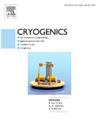样品厚度对单畴REBa2Cu3O7-δ块体超导体捕获场的影响
IF 2.1
3区 工程技术
Q3 PHYSICS, APPLIED
引用次数: 0
摘要
研究单畴REBa2Cu3O7-δ (REBCO, RE为稀土元素)超导块状材料的俘获场(Btr)对提高其性能和推进其实际应用具有重要意义。考虑超导体的临界电流密度、超导体的直径和厚度以及观测高度等关键参数,构建了一个综合的物理模型。基于Biot-Savart定律和有限元法,建立了计算REBCO块体捕获场的数学模型,并利用MATLAB软件进行了仿真。在本研究中,将REBCO块体超导体的临界电流密度设定为31150 A/cm2,固定直径为20 mm,厚度为2 ~ 40 mm。数值模拟了块状超导体表面上方0.5 mm处的捕获场。结果表明:Btr随厚度的增加而增大,当厚度达到30 mm左右时达到饱和,厚度与直径比约为1.5;本研究为制备高质量REBCO块状超导样品提供了参考,并为捕获磁场研究提供了新的见解。本文章由计算机程序翻译,如有差异,请以英文原文为准。
The influence of sample thickness on the trapped field in single-domain REBa2Cu3O7-δ bulk superconductors
Investigating the trapped field (Btr) of single-domain REBa2Cu3O7-δ (REBCO, RE is Rare Earth Elements) superconducting bulk materials is crucial for enhancing their performance, as well as advancing their practical applications. This study constructs a comprehensive physical model, considering key parameters including the critical current density of superconducting bulks, their diameter and thickness, as well as the observation height. A mathematical model for calculating the trapped field of REBCO bulks has been developed based on the Biot-Savart law and the Finite Element Method, and simulated using Matrix Laboratory (MATLAB) software. In this study, the critical current density of the REBCO bulk superconductor was set to 31,150 A/cm2, with a fixed diameter of 20 mm and thickness varying from 2 mm to 40 mm. The trapped field was numerically simulated at a position 0.5 mm above the surface of the bulk superconductor. The results show that the Btr increases with thickness and saturates when the thickness reaches approximately 30 mm—thickness-to-diameter ratio is approximately 1.5. This study serves as a reference for the preparation of high-quality REBCO bulk superconducting samples and provides novel insights into trapped magnetic field research.
求助全文
通过发布文献求助,成功后即可免费获取论文全文。
去求助
来源期刊

Cryogenics
物理-热力学
CiteScore
3.80
自引率
9.50%
发文量
0
审稿时长
2.1 months
期刊介绍:
Cryogenics is the world''s leading journal focusing on all aspects of cryoengineering and cryogenics. Papers published in Cryogenics cover a wide variety of subjects in low temperature engineering and research. Among the areas covered are:
- Applications of superconductivity: magnets, electronics, devices
- Superconductors and their properties
- Properties of materials: metals, alloys, composites, polymers, insulations
- New applications of cryogenic technology to processes, devices, machinery
- Refrigeration and liquefaction technology
- Thermodynamics
- Fluid properties and fluid mechanics
- Heat transfer
- Thermometry and measurement science
- Cryogenics in medicine
- Cryoelectronics
 求助内容:
求助内容: 应助结果提醒方式:
应助结果提醒方式:


